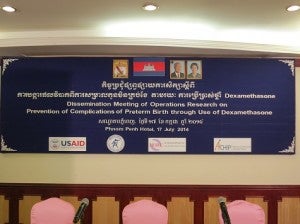This article was originally posted by MCHIP on July 18th, 2014
 In recent years, Cambodia has received international praise for improvements in maternal and child health. The Ministry of Health (MOH), however, has recognized that tremendous challenges still persist in the area of newborn health. In particular, preterm birth—a live birth that occurs before 37 completed weeks of pregnancy—remains a prominent issue due to its direct link with high rates of mortality and morbidity among newborns. With the country’s preterm birthrate at 10.5%1 and a neonatal mortality rate of 27 deaths per 1,000 live births, Cambodia’s MOH has committed itself to improving newborn health and decreasing newborn mortality.
In recent years, Cambodia has received international praise for improvements in maternal and child health. The Ministry of Health (MOH), however, has recognized that tremendous challenges still persist in the area of newborn health. In particular, preterm birth—a live birth that occurs before 37 completed weeks of pregnancy—remains a prominent issue due to its direct link with high rates of mortality and morbidity among newborns. With the country’s preterm birthrate at 10.5%1 and a neonatal mortality rate of 27 deaths per 1,000 live births, Cambodia’s MOH has committed itself to improving newborn health and decreasing newborn mortality.
This week, numerous officials from the Government of Cambodia, USAID, MCHIP and other stakeholders attended a national dissemination meeting in Phnom Penh to share the results of an MCHIP supported study that calls for increased coverage of antenatal corticosteroids (ACS) in the management of the country’s preterms. ACS are one of the most effective interventions for improving preterm survival, reducing death by 31% by augmenting maturation of the premature fetus’ lungs.
Dr. Tung Rathavy and Dr. Keth Lysotha—Director and Deputy Directory, respectively, of the National Maternal Child Health Center (NMCHC)—were in attendance, along with USAID’s Sheri-Nouane Duncan-Jones (Director, Office of Public Health and Education), and USAID/Cambodia’s Robin Mardeusz (Maternal and Child Health Team Leader, Office of Public Health & Education).
The lessons learned from the intervention have substantial implications for reducing the country’s newborn mortality. Directed by the MOH, NMCHC, and the sub-technical working group on maternal child health, the study sought to improve the quality of care given to pregnant women at risk of imminent preterm birth in six different Cambodian facilities. (Human Development Research Cambodia (HDRC) worked closely with NMCHC on local research, and MCHIP provided overall technical support.)
The intervention called for increased coverage of dexamethasone—the most commonly found ACS—to these women in order to reduce complications of prematurity among preterm newborns. The drug is recommended for women with preterm labor, because it is known to improve health outcomes for premature newborns by reducing the chances of related complications if administered before birth.
In just a short time (less than one year), the overall coverage rates of dexamethasone in the facilities across Cambodia dramatically increased from 34.9% at baseline to 86.1% at endline. Rapid increase in utilization even took place at facilities that had limited knowledge and use of the drug prior to the intervention. Dexamethasone is inexpensive and widely available in hospitals throughout Cambodia, so with increased guidelines and technical supervision, the neonatal intervention was able to produce substantial results even in the most limited facilities. The coverage rate was only for those women who were at risk of imminent preterm birth.
These results are promising because they demonstrate that when strong technical leadership and clinical governance in facilities are combined, the ability of simple, evidence-based interventions—such as increasing the rate of administration of dexamethasone—can be effectively scaled up Cambodia. Providers could alter their behaviors and increase utilization because strong buy in from facilities and increased technical support created an environment that was conducive for implementing correct practices.
The dramatic increase in coverage of dexamethasone in such a short period of time is an incredibly encouraging outcome. With continued emphasis on stronger clinical guidelines and additional technical supervision, increases in the utilization of ACS could be replicated more extensively in other facilities within Cambodia. If the MOH sustains its commitment to scale-up the use of dexamethasone and other interventions for preterm birth, major progress towards reductions in neonatal mortality and morbidity are possible.
1 2012 Born Too Soon report
